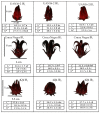Anthocyanin Induction by Drought Stress in the Calyx of Roselle Cultivars
- PMID: 32231098
- PMCID: PMC7180819
- DOI: 10.3390/molecules25071555
Anthocyanin Induction by Drought Stress in the Calyx of Roselle Cultivars
Abstract
Abiotic factors can alter the chemical profile of crops and the number of compounds they contain. In this study, the anthocyanin and anthocyanidin contents, determined by ultra-performance liquid chromatography (UPLC-MS/MS), and the colour attributes of the calyces of three cultivars of Hibiscus sabdariffa subjected to three water stress regimes during the stage of physiological maturity were investigated. The total anthocyanin content in calyx increased relative to the control content under a 65% moisture irrigation regime. Among the cultivars, UAN16-2 showed the greatest increases in the contents of cyanidin, delphinidin 3-O-glucoside, cyanidin 3-O-glucoside, and cyanidin 3-O-sambubioside. The content of cyanidin 3-O-sambubioside showed the greatest increase, increasing by 55% relative to the control level. The contents of these compounds are correlated with colour attributes such as luminosity. Water stress under the 33% moisture condition during plant development led to decreased anthocyanin contents in all of the roselle cultivars.
Keywords: Hibiscus sabdariffa; UPLC-MS/MS analysis; anthocyanins; colour; drought stress; greenhouse.
Conflict of interest statement
The authors declare no conflict of interest.
Figures





References
-
- Hinojosa-Gómez J., San Martin-Hernández C., Heredia J.B., León-Félix J., Osuna-Enciso T., Muy-Rangel M.D. Roselle (Hibiscus sabdariffa L.) cultivars calyx produced hydroponically: Physicochemical and nutritional quality. Chil. J. Agric. Res. 2018;78:478–485. doi: 10.4067/S0718-58392018000400478. - DOI
-
- Fernández-Arroyo S., Rodríguez-Medina I.C., Beltrán-Debón R., Pasini F., Joven J., Micol V., Segura-Carreero A., Fernández-Gutiérrez A. Quantification of the polyphenolic fraction and in vitro antioxidant and in vivo anti-hyperlipemic activities of Hibiscus sabdariffa aqueous extract. Food Res. Int. 2011;44:1490–1495. doi: 10.1016/j.foodres.2011.03.040. - DOI
MeSH terms
Substances
LinkOut - more resources
Full Text Sources

